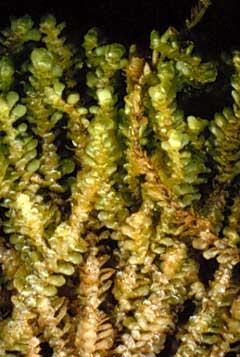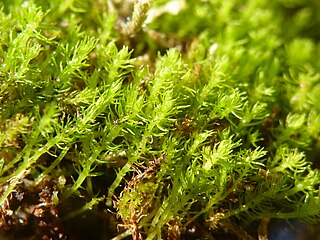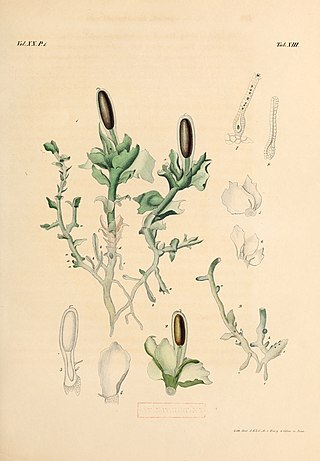
Jungermanniales is the largest order of liverworts. They are distinctive among the liverworts for having thin leaf-like flaps on either side of the stem. Most other liverworts are thalloid, with no leaves. Due to their dorsiventral organization and scale-like, overlapping leaves, the Jungermanniales are sometimes called "scale-mosses".

Takakia is a genus of two species of mosses known from western North America and central and eastern Asia. The genus is placed as a separate family, order and class among the mosses. It has had a history of uncertain placement, but the discovery of sporophytes clearly of the moss-type firmly supports placement with the mosses.
Folioceros is a genus of hornworts in the family Anthocerotaceae. The genus is common locally in the tropical and subtropical regions of Asia, growing on moist rocks, in fallow fields, and near waterfalls. It has a yellow-green gametophyte thallus that is crispy and translucent, with short branchings that are almost pinnate. Plants are usually less than a centimeter wide and 3 centimeters long. They may be monoicous or dioicous.
Haesselia is a genus of liverworts in the family Cephaloziaceae. It contains the following species :
Hattoria yakushimensis is the only species of liverwort in the genus Hattoria, in the family Anastrophyllaceae. It is endemic to Japan. Its natural habitat is temperate forests. It is threatened by habitat loss.
Perssoniella vitreocincta is the only species of liverwort in the monotypic genus Perssoniella and family Perssoniellaceae. It is endemic to New Caledonia.
Vandiemenia ratkowskiana is the only species of liverwort in the genus Vandiemenia. It is endemic to Tasmania, Australia. Its natural habitat is subtropical or tropical dry forests.

Haplomitriopsida is a newly recognized class of liverworts comprising fifteen species in three genera. Recent cladistic analyses of nuclear, mitochondrial, and plastid gene sequences place this monophyletic group as the basal sister group to all other liverworts. The group thus provides a unique insight into the early evolution of liverworts in particular and of land plants in general.
Apotreubia is a genus of liverworts in the family Treubiaceae. There are four species, including: Apotreubia nana, which is found in subalpine New Guinea, and Apotreubia pusilla, which has a disjunct distribution between eastern Asia and British Columbia.
Hiroshi Inoue was a Japanese botanist specializing in bryology.

Sandeothallus is a small genus of liverworts restricted to East Asia. It is classified in the order of Pallaviciniales and is the only member of the family, Sandeothallaceae within that order.
Trichotemnoma is a genus of liverworts restricted to New Zealand and Tasmania, and contains a single species Trichotemnoma corrugatum. It is classified in the order Jungermanniales and is the only member of the family Trichotemnomataceae within that order. The generic name Trichotemnona was originally published in 1964, but that publication was invalid under the ICBN.

William Campbell Steere (1907–1989) was an American botanist known as an expert on bryophytes, especially arctic and tropical American species. The standard author abbreviation Steere is used to indicate this person as the author when citing a botanical name.

Calypogeiaceae is a family of liverworts. This type of plant is a calcifuge.

Aneura is a genus of liverworts in the family Aneuraceae.
Gottschelia is a genus of liverworts belonging to the family Cephaloziellaceae.
Elizabeth Anne Brown was a New Zealand-born Australian bryologist who primarily contributed to the systematics of liverworts.
Herzogianthaceae is a family of liverworts belonging to the order Ptilidiales. The monotypic family consists of only one genus: HerzogianthusR.M.Schust..

Jackiellaceae is a family of liverworts belonging to the order Jungermanniales. The family consists of only one genus: Jackiella.

Siegfried Huneck was a German chemist and lichenologist. Much of his scientific career was hampered by the political situation in the former German Democratic Republic. He rejected pursuing a career in academia, and instead ended up working at the Leibniz Institute of Plant Biochemistry, a public research institute, from 1969 until his retirement in 1993. Despite his relative isolation and restricted freedoms in East Germany, Huneck had numerous professional contacts both in Germany and abroad, and was a highly published scholar. Many of his more than 400 scientific publications dealt with the chemistry of lichen products. He was awarded the Acharius Medal for lifetime achievements in lichenology in 1996.








